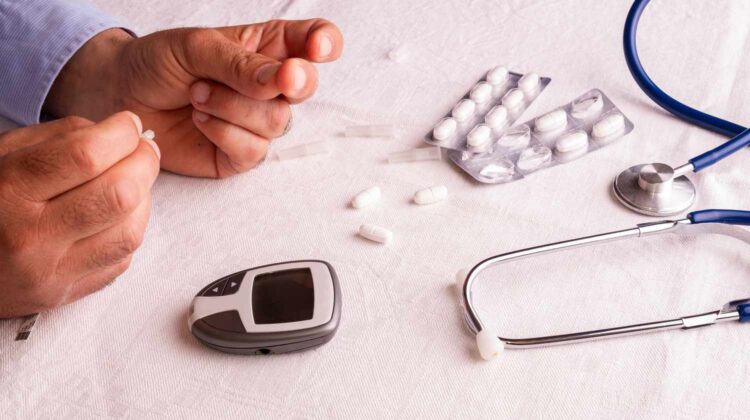
Maintaining optimal blood sugar levels is a critical aspect of overall health, with imbalances posing significant risks such as diabetes and related complications. In the pursuit of effective solutions, the intersection of natural compounds and innovative approaches to blood sugar management has become an area of intense exploration. One intriguing avenue of research involves the combination of Turkesterone, a naturally occurring ecdysteroid compound, with Glucose Disposal Agents (GDAs), substances known for their ability to enhance glucose uptake and utilization. This article delves into the promising synergy between Turkesterone and GDAs, aiming to shed light on their collective potential in improving blood sugar control.
As we navigate the landscape of metabolic health, understanding the unique properties and mechanisms of action of Turkesterone becomes paramount. Derived from plants like Ajuga turkestanica, Turkesterone has garnered attention for its diverse physiological effects, particularly on metabolism. Additionally, the role of GDAs in facilitating the efficient disposal of glucose is well-established, making them a subject of interest for those seeking innovative strategies to manage blood sugar levels.
Understanding Turkesterone
Turkesterone, hailed as a potent phytoecdysteroid, has garnered significant attention for its potential health benefits. Let’s delve into its intricacies, from its definition to its mechanisms of action and the research backing its effects on metabolism.
Definition and Natural Sources
Turkesterone is a naturally occurring compound primarily found in plants like Ajuga turkestanica, Rhaponticum carthamoides, and insects like the Ajuga turkestanica bug. As a phytoecdysteroid, it functions as a growth regulator in plants and exhibits remarkable adaptogenic properties. turkesterone is commonly extracted from these botanical sources for various health supplements and nutritional products.
Biochemical Properties and Mechanisms of Action
- Unique Structure: Turkesterone boasts a unique chemical structure characterized by its nucleus and ecdysteroid skeleton, contributing to its physiological effects.
- Activation of Anabolic Pathways: Research suggests that turkesterone may activate anabolic pathways in the body, promoting protein synthesis and muscle growth.
- Metabolic Regulation: Turkesterone exhibits potential in modulating glucose and lipid metabolism, contributing to improved energy regulation and endurance.
- Adaptogenic Properties: Turkesterone’s adaptogenic properties enable it to help the body adapt to stressors, supporting overall resilience and vitality.
Previous Research on Turkesterone’s Impact on Metabolism
- Muscle Protein Synthesis: Studies have demonstrated turkesterone’s ability to enhance muscle protein synthesis, potentially leading to increased muscle mass and strength.
- Metabolic Rate: Research indicates that turkesterone may influence metabolic rate, contributing to enhanced calorie expenditure and weight management.
- Glucose Homeostasis: Some studies suggest that turkesterone may aid in maintaining stable blood glucose levels by improving insulin sensitivity and glucose uptake in cells.
- Lipid Profile: Preliminary findings hint at turkesterone’s potential to positively impact lipid profiles by reducing LDL cholesterol levels and increasing HDL cholesterol.
Glucose Disposal Agents (GDA)
Understanding the role of Glucose Disposal Agents (GDAs) in blood sugar regulation is pivotal in exploring avenues for improved metabolic health. This section will cover the definition, various types, and the existing body of research on the effectiveness of GDAs in managing blood sugar levels.
Definition and Role in Blood Sugar Regulation
Glucose Disposal Agents, often abbreviated as GDAs, are compounds that play a crucial role in the regulation of blood sugar levels. Their primary function is to enhance the body’s ability to utilize glucose efficiently, promoting its uptake by cells for energy production. GDAs work by improving insulin sensitivity, reducing insulin resistance, and facilitating the transportation of glucose into cells, particularly muscle cells.
Common Types of GDAs and How They Function
- Berberine: Derived from various plants, berberine is known to activate AMP-activated protein kinase (AMPK), a cellular energy sensor. This activation enhances glucose uptake and utilization while improving insulin sensitivity.
- Alpha-Lipoic Acid (ALA): An antioxidant, ALA enhances insulin sensitivity and stimulates glucose uptake by skeletal muscle cells. It also has anti-inflammatory properties, contributing to overall metabolic health.
- Cinnamon Extract: Rich in bioactive compounds, cinnamon extract has been linked to improved insulin sensitivity and reduced fasting blood glucose levels.
- Chromium: An essential mineral, chromium enhances insulin’s effectiveness, promoting glucose uptake and metabolism. It is often found in GDA supplements to support blood sugar regulation.
- Fenugreek Extract: Rich in soluble fiber, fenugreek extract slows down the absorption of glucose in the intestines, aiding in blood sugar control.
Existing Studies on the Effectiveness of GDAs in Managing Blood Sugar Levels
- Berberine and Insulin Sensitivity: Several studies have highlighted berberine’s efficacy in improving insulin sensitivity and reducing fasting blood glucose levels, making it a potential GDA for individuals with insulin resistance.
- Alpha-Lipoic Acid and Type 2 Diabetes: Research indicates that ALA supplementation may improve insulin sensitivity in individuals with type 2 diabetes, showcasing its potential as a GDA.
- Cinnamon Extract and Glycemic Control: Studies suggest that cinnamon extract may have a beneficial impact on glycemic control by lowering fasting blood glucose levels and improving insulin sensitivity.
- Chromium Supplementation: Research on chromium supplementation indicates potential benefits in enhancing insulin sensitivity and improving glucose metabolism, especially in individuals with chromium deficiency.
- Fenugreek and Blood Sugar Levels: Studies on fenugreek extract have demonstrated its ability to lower fasting blood glucose levels and improve insulin sensitivity in individuals with diabetes.
The Need for Improved Blood Sugar Control
As the prevalence of diabetes and associated health concerns continues to rise globally, there is an urgent need for effective strategies to manage blood sugar levels. This section addresses the growing health issues, the challenges individuals face in maintaining stable blood sugar, and the potential role that Turkesterone and glucose disposal agents (GDAs) may play in addressing these challenges.
Rising Prevalence of Diabetes and Related Health Issues
- Epidemic Proportions: Diabetes has reached epidemic proportions, affecting millions worldwide. The World Health Organization (WHO) estimates that the number of people with diabetes has quadrupled since 1980, and it continues to rise.
- Health Consequences: Diabetes is not only a standalone health concern but also a precursor to various complications such as cardiovascular diseases, kidney disorders, and nerve damage. The economic burden of managing diabetes and its complications is substantial.
- Lifestyle Factors: Sedentary lifestyles, unhealthy dietary habits, and genetic predispositions contribute to the surge in diabetes cases. The need for preventive measures and effective management strategies has never been more critical.
Current Challenges in Maintaining Stable Blood Sugar Levels
- Insulin Resistance: Many individuals struggle with insulin resistance, where cells fail to respond effectively to insulin, resulting in elevated blood sugar levels.
- Fluctuating Blood Sugar: Achieving and maintaining stable blood sugar levels can be challenging due to factors like irregular eating patterns, stress, and varying physical activity levels.
- Limited Treatment Options: While there are medications available for managing diabetes, they often come with side effects and may not address the root causes of blood sugar dysregulation.
The Potential Role of Turkesterone and GDAs in Addressing These Challenges
- Turkesterone as a Metabolic Modulator: Turkesterone, with its reported impact on glucose and lipid metabolism, presents itself as a potential ally in addressing insulin resistance and stabilizing blood sugar levels.
- GDAs Enhancing Insulin Sensitivity: Glucose Disposal Agents, by enhancing insulin sensitivity and promoting efficient glucose utilization, have the potential to mitigate insulin resistance and contribute to better blood sugar control.
- Comprehensive Approach: The combination of Turkesterone and GDAs may offer a comprehensive approach to blood sugar management. Turkesterone’s adaptogenic properties, coupled with the insulin-sensitizing effects of GDAs, could address the multifaceted challenges individuals face in controlling blood sugar levels.
Synergistic Effects of Turkesterone and GDA
The combination of Turkesterone and Glucose Disposal Agents (GDAs) holds the potential for a synergistic impact on various aspects of metabolic health. Understanding the individual benefits of each and exploring the ways in which they may complement each other provides insights into the promising synergy that this combination might offer.
Overview of Individual Benefits of Turkesterone and GDAs
Turkesterone’s Benefits:
- Muscle Protein Synthesis: Turkesterone has been associated with increased muscle protein synthesis, promoting muscle growth and strength.
- Metabolic Regulation: Studies suggest that Turkesterone may play a role in modulating glucose and lipid metabolism, contributing to improved energy regulation.
- Adaptogenic Properties: Turkesterone’s adaptogenic properties enhance the body’s ability to adapt to stressors, supporting overall resilience and vitality.
GDAs’ Benefits:
- Insulin Sensitivity: Glucose Disposal Agents enhance insulin sensitivity, promoting efficient glucose uptake by cells and reducing insulin resistance.
- Blood Sugar Control: GDAs contribute to maintaining stable blood sugar levels by improving the body’s ability to dispose of glucose, particularly in muscle cells.
- Metabolic Support: Various GDAs, such as berberine and alpha-lipoic acid, offer antioxidant properties and support overall metabolic health.
Exploration of Potential Synergies between Turkesterone and GDAs
Enhanced Insulin Sensitivity:
- Turkesterone’s reported ability to improve insulin sensitivity may synergize with GDAs, amplifying the overall effect on glucose uptake by cells.
Optimized Muscle Protein Synthesis:
- GDAs, by facilitating glucose uptake in muscle cells, may enhance the substrate availability for muscle protein synthesis, complementing Turkesterone’s muscle-building properties.
Balanced Metabolic Regulation:
- Turkesterone’s role in metabolic regulation, coupled with GDAs’ support for glucose and lipid metabolism, may create a balanced environment for energy utilization and storage.
Mechanisms Through Which Turkesterone and GDAs May Complement Each Other
Insulin Sensitization:
- Turkesterone’s reported impact on insulin sensitivity may enhance GDAs’ effects, collectively improving insulin-mediated glucose uptake and utilization.
Cellular Energy Optimization:
- Turkesterone’s influence on metabolic pathways, combined with GDAs’ support for efficient glucose disposal, may optimize cellular energy production and utilization.
Holistic Metabolic Support:
- The adaptogenic properties of Turkesterone, coupled with the metabolic support provided by GDAs, may offer a holistic approach to metabolic health, addressing multiple facets of blood sugar regulation.
The combination of Turkesterone and GDAs presents a synergistic approach to metabolic health. By harnessing the individual benefits of each compound and exploring the potential synergies, this combination may offer a comprehensive strategy for individuals seeking to optimize muscle growth, metabolic regulation, and blood sugar control.
Conclusion:
In the quest for optimal blood sugar control and metabolic health, the combined potential of Turkesterone and Glucose Disposal Agents (GDAs) emerges as a promising frontier. As highlighted in the exploration of Turkesterone’s individual benefits and the mechanisms of action, its unique properties, such as adaptogenic capabilities and impact on muscle protein synthesis, position it as a compelling component in the pursuit of balanced metabolic function.
Simultaneously, the discussion on GDAs, encompassing their diverse types and proven effectiveness in enhancing insulin sensitivity and blood sugar control, adds depth to the comprehensive approach to metabolic health. The integration of Turkesterone and GDAs represents a strategic alliance, as explored in the section on the synergistic effects. Their combined benefits, from optimized muscle protein synthesis to enhanced insulin sensitivity and balanced metabolic regulation, suggest a holistic strategy for individuals grappling with blood sugar challenges.

